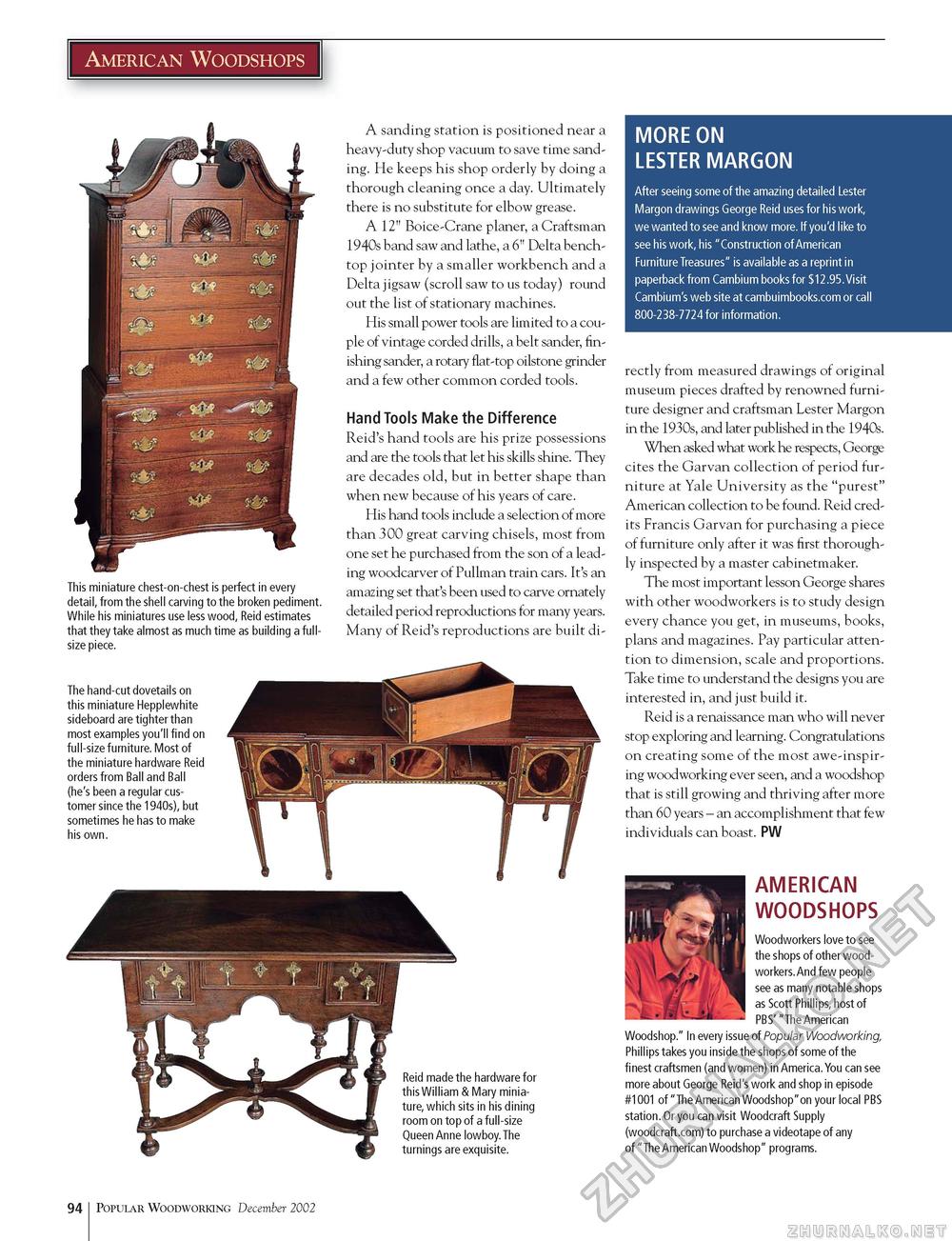Popular Woodworking 2002-12 № 131, страница 89
MORE ON LESTER MARGON After seeing some of the amazing detailed Lester Margon drawings George Reid uses for his work, we wanted to see and know more. If you'd like to see his work, his "Construction of American Furniture Treasures" is available as a reprint in paperback from Cambium books for $12.95.Visit Cambium's web site at cambuimbooks.com or call 800-238-7724 for information. American Woodshops This miniature chest-on-chest is perfect in every detail, from the shell carving to the broken pediment. While his miniatures use less wood, Reid estimates that they take almost as much time as building a full-size piece. The hand-cut dovetails on this miniature Hepplewhite sideboard are tighter than most examples you'll find on full-size furniture. Most of the miniature hardware Reid orders from Ball and Ball (he's been a regular customer since the 1940s), but sometimes he has to make his own. A sanding station is positioned near a heavy-duty shop vacuum to save time sanding. He keeps his shop orderly by doing a thorough cleaning once a day. Ultimately there is no substitute for elbow grease. A 12" Boice-Crane planer, a Craftsman 1940s band saw and lathe, a 6" Delta bench-top jointer by a smaller workbench and a Delta jigsaw (scroll saw to us today) round out the list of stationary machines. His small power tools are limited to a couple of vintage corded drills, a belt sander, finishing sander, a rotary flat-top oilstone grinder and a few other common corded tools. Hand Tools Make the Difference Reid's hand tools are his prize possessions and are the tools that let his skills shine. They are decades old, but in better shape than when new because of his years of care. His hand tools include a selection of more than 300 great carving chisels, most from one set he purchased from the son of a leading woodcarver of Pullman train cars. It's an amazing set that's been used to carve ornately detailed period reproductions for many years. Many of Reid's reproductions are built di- rectly from measured drawings of original museum pieces drafted by renowned furniture designer and craftsman Lester Margon in the 1930s, and later published in the 1940s. When asked what work he respects, George cites the Garvan collection of period furniture at Yale University as the "purest" American collection to be found. Reid credits Francis Garvan for purchasing a piece of furniture only after it was first thoroughly inspected by a master cabinetmaker. The most important lesson George shares with other woodworkers is to study design every chance you get, in museums, books, plans and magazines. Pay particular attention to dimension, scale and proportions. Take time to understand the designs you are interested in, and just build it. Reid is a renaissance man who will never stop exploring and learning. Congratulations on creating some of the most awe-inspiring woodworking ever seen, and a woodshop that is still growing and thriving after more than 60 years - an accomplishment that few individuals can boast. PW Reid made the hardware for this William & Mary miniature, which sits in his dining room on top of a full-size Queen Anne lowboy. The turnings are exquisite. AMERICAN WOODSHOPS Woodworkers love to see the shops of other wood-workers.And few people see as many notable shops as Scott Phillips, host of PBS' "The American Woodshop." In every issue of Popular Woodworking, Phillips takes you inside the shops of some of the finest craftsmen (and women) in America.You can see more about George Reid's work and shop in episode #1001 of "The American Woodshop"on your local PBS station. Or you can visit Woodcraft Supply (woodcraft.com) to purchase a videotape of any of "The American Woodshop" programs. 94 Popular Woodworking December 2002 |








